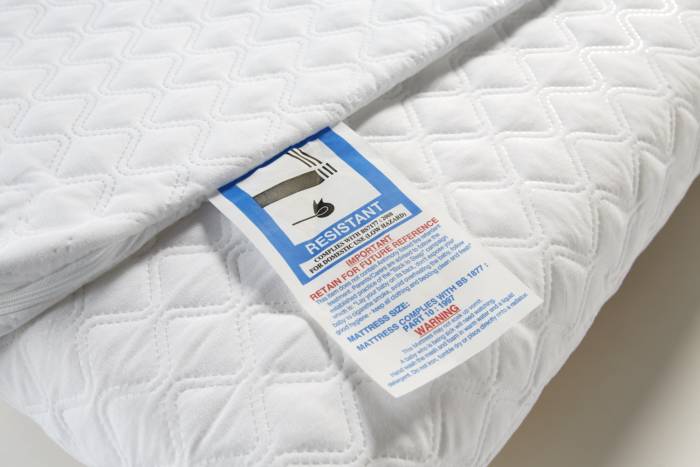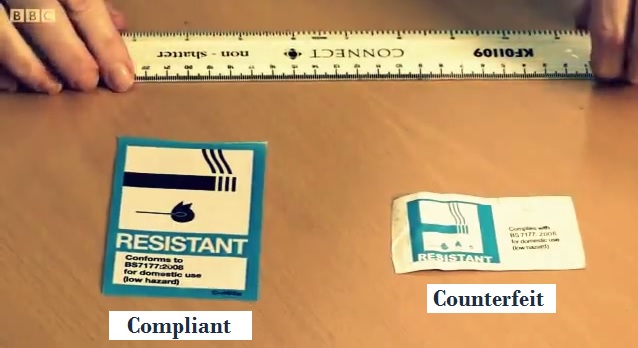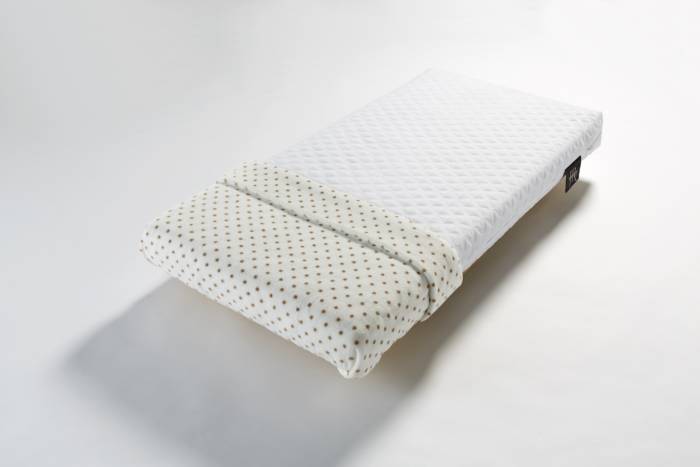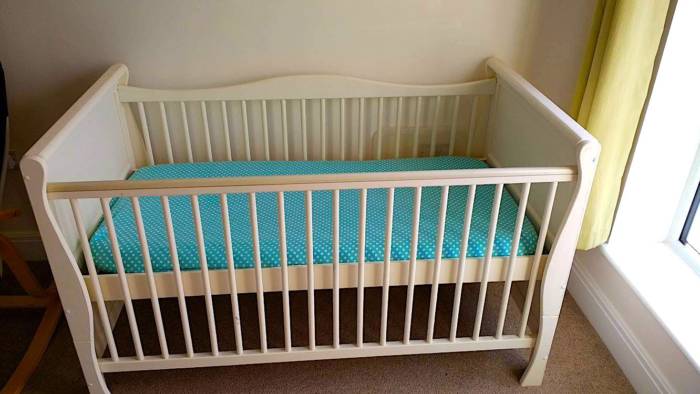Cot Mattresses
November 2016Cot Mattress Safety
Whether its regulations to ensure your mattress is compliant or the chemical composition of some products that may be unsafe for babies this article will take you through a number of safety concerns and provide advice as to how to best reduce the risks.

All home furnishings and mattresses must comply with a number of safety regulations. These regulations came into force in 1988 and are the product of a series of catastrophic house fires. These were caused by either home electrical items or where furniture had combusted, usually by lit cigarettes falling on them, causing either death or serious injury. It led to the creation of safety standards and regulations to ensure that products in a domestic setting are as safe as possible for UK consumers. These can be split into fire regulations and safety certification regulations.
Cot Mattress Fire Retardancy
Fire retardancy or FR applies to all mattresses and every product sold in the UK should adhere to these standards. The standards are set by British regulations (BS 5852: 1982 Part II & BS 7177). You can check products by inspecting the FR label. An example of an official label can be seen below and we have a detailed article dedicated to FR in mattresses here. This ensures that the product won’t combust when either a lit cigarette or a match is dropped onto it. It should smoulder but never ignite, the tests are stringent for good reason. A cot mattress should always carry this label.

Cheaper imported foams have been seen to fail fire retardancy regulations and the numerous recalls over the years about unsafe foams have rightly caused outrage by consumers. Even recently there have been numerous press stories about imported foam that fails both the FR test and also contains restricted or banned chemical compounds. The best way to avoid this is to steer well clear of foams and cheap synthetic cot mattresses. Counterfeit labels have also been found, could this get any more worrying, we have an example below so you can spot the real from the fake.

Cot mattress regulations BS 1877-10:2011+A1:2012
Any cot mattress should be made to be certified as BS 1877-10:2011+A1:2012 compliant. These are the UK based regulations to ensure that cot mattresses and associated products are safe and fit for purpose. We have included a summary of the most pertinent points here. If you want to read the entire regulation you can purchase them from FIRA.
- The fabric needs to pass a number of criteria, such as colour fasting, tear strength, seam slippage and tensile strength.
- The mattress components also have stringent regulations such as any gaps found in a mattress must pass a probe test to ensure a babies fingers can’t get caught in it.
- There are also rules about the exact sizing of cot mattresses so a babies fingers/hands can’t get trapped down the edge and that the mattress doesn’t exceed 10cm in depth so the baby can’t climb out of the cot.
VOC, Phthalates & Chemical Offgassing
Volatile organic compounds (VOC’s) have long been the subject of mattress construction, especially with cheap imported foams. These VOC’s off-gas from the product and can cause an unpleasant smell and some pretty worrying side effects, we have much more detail on off-gassing and VOC’s here. With a natural product, you don’t have this same concern as the chemicals used to treat them are far lower than entirely synthetic compounds. There will always be some form of chemical treatment of furniture and mattresses even just in the cleaning process but the aim is to keep this to a minimum by using natural fibres where possible.
 Phthalates and organotins are another concern for new parents and these caused a massive scare during the 2000’s when studies into phthalates revealed that these chemicals can potentially leach out of plastic or vinyl treated products. In 2012, restrictions have been imposed by the Registration, Evaluation and Authorisation of Chemicals (REACH) on the use of certain organotins. The EU regulates the use of phthalates but products imported from outside the UK, especially cheap auction bought mattresses, can still contain these.
Phthalates and organotins are another concern for new parents and these caused a massive scare during the 2000’s when studies into phthalates revealed that these chemicals can potentially leach out of plastic or vinyl treated products. In 2012, restrictions have been imposed by the Registration, Evaluation and Authorisation of Chemicals (REACH) on the use of certain organotins. The EU regulates the use of phthalates but products imported from outside the UK, especially cheap auction bought mattresses, can still contain these.
The cot mattress industry primarily used vinyl surface coverings to cover foam mattresses. This polyvinyl chloride (PVC) surface leaked phthalates which can then be ingested via breathing or orally via babies chewing toys or even mattress covers. You can check the chemical composition of products to see if they contain phthalates but with mattresses, many manufacturers don’t give you any real detail on the covers or upholstery. Again, our advice would be to avoid plastic ‘wipe clean’ covers if you’re concerned about phthalates.
Reducing SIDS (Sudden Infant Death Syndrome)
Whilst we aim to keep this site up to date as best we can we would always advise you visit the NHS website for cot mattress safety guidelines. Here we offer some guidance as a starter for ten but always advise you seek help from both the NHS and other reputable sources.
It’s every parent’s worst nightmare that SIDS, sometimes referred to as cot death, may occur when babies are asleep. It’s an area that has been covered in detail by numerous research studies, the press and the NHS. The NHS have written some excellent guidelines in relation to SIDS which should help reduce the risk of it occurring. The difficulty is that because there’s no exact reason for this syndrome its hard to write about the best method to remove the risk. There are some guidelines to reduce the likelihood of SIDS listed below to help.
Foot to foot sleeping position: Putting your baby in the foot to foot sleeping position, where the feet are at the bottom of the crib, and adequately tucked into the blanket is the most widely advised technique. Along with some other ‘common sense’ tips to help keep your baby safe and sound. Do not allow the blanket to cover your babies head.

Never sleep with a baby on a sofa: Always make sure that baby sleeps in their cot or cot bed. Falling asleep on a sofa can lead to unsafe sleeping positions for babies.
Understand the risks of co-sleeping: If your baby was premature there are suggestions that co-sleeping can be dangerous. The advice is always to let your baby sleep in its cot bed in the same room as you but not in bed with you. Rolling out of bed or being rolled onto are the biggest risks in co-sleeping.
Cot Mattress Safety Guidelines
The following guidelines should act as a baseline to ensure your cot mattress provides your baby with a perfect nights sleep whilst also keeping them safe and sound.
- Ensure mattress covers, comforters and blankets are clean
- Wash cot covers and blankets at 60 degrees
- Ensure the mattress is not too soft opting for a firmer feel
- Check that the cot mattress does not sag ie cheaper thin foams
- Ensure the mattress shows no signs of deterioration
- Clean up spills or accidents as soon as possible
- Air any damp or moist areas once cleaned

Baby safe sleeper guidelines
- There is an increased risk of SIDS /cot death if a baby’s head is covered by blankets.
- We recommend that you place your baby in the ‘feet to foot’ position ie with the feet at the foot of the mattress.
- Tuck blankets in securely at the bottom of the mattress, reaching no higher than the baby’s shoulder. This helps prevent the baby from wriggling under the blankets.
- Always ensure a good close fit of the mattress in the cot.
- Replace covers if you damage them or they get snagged during refitting.
- Place your baby on its back to sleep
- Do not let your baby get too hot/cold
- Do not let anyone smoke in the same room as your baby
- Do not fall asleep with your baby on a sofa
- Do not share a bed with your baby if you are a smoker, have been drinking alcohol or taking drugs/medication that may make you drowsy or tired.
- If you are worried that your baby is unwell, seek medical advice promptly
It’s never pleasant writing about the risks to babies with mattresses or infant products but it is an area that does need parental attention and diligence. Our products are all completely compliant with BS 1877-10:2011+A1:2012 and the FR standards. As our cot mattress is made from natural coir and lambswool off-gassing is at a minimum due to the absence of chemicals or foams.
We only use breathable cotton and polyester blended covers, which are waterproof – again helping to reduce the concern over synthetic products impacting your babies sleep or health. All of our products are made by hand here in the UK and we never import cheaper products like some retailers.
Summary
For more general information on cot mattresses, including how to choose the right one, please see our guide “Cot Mattresses Explained”. We also welcome discussion on our “Ask us” forum and we respond to all queries within 1 business day. So if you have any more questions on cot mattress safety why not submit your question to help other new parents?

Dreaming of the perfect nights sleep?

Ask us a question
There are over 6000 questions and answers submitted by you on all questions about mattresses and bed problems. Enter a keyword such as Vi Spring, John Lewis beds, bad back or Memory Foam and see if your question has already been answered.
If you can’t find an answer in knowledge hub, ask a new question. We aim to respond to all questions within one working day.
Newsletter
Enter your email to join our newsletter. We’ll send you occasional news and mattress expertise.
